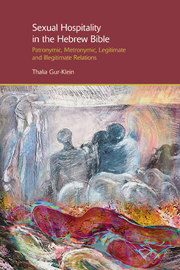 Sexual Hospitality in the Hebrew Bible
Sexual Hospitality in the Hebrew Bible Multiplicity of conjugal patterns, I
Sexuality wavers between the physiological, socio-cultural and economic strata; the social realm represents bars and prohibitions on sexual relations, while the physical world implies drives to satisfy sexuality. While the physical realm resides in the personal domain, culture materializes in the social realm of laws and customs while inhering in interrelations with others (Lévi-Strauss 1969: 12; Frymer-Kensky 1999: 293).
Expanding on these propositions, the socio-cultural and economic strata precipitate imposition of various systems on sexual relations. Accordingly, Robertson Smith proposes that different social classes and economic levels abide by differentiating types of conjugal bonds, connubial rules and marital status in Ancient Arabia (Robertson Smith [1885] 1907: 271–2). This postulation will be expounded to fit biblical texts in the following.
Biblical texts suggest that the rich and the royal can afford a polygamous house-hold, which generates its own rules, contracts, conjugal relations and marital statuses. Solomon's harem consists of one husband and one thousand women acquired from far and wide, presumably by political ties or purchase. The women are ranked according to a sliding scale, with high-status wives being accorded first-wife status, while women of lower socio-economic families are called concubines, denoting secondary status. Slave-wives or female slaves are not counted (1 Kgs 11:1–3). Conversely, a small farm holder like Elimelech has one wife who solely holds the position of his chief-wife and materfamilias (Ruth 1:1–2). An impoverished man may not be able to acquire and maintain a wife.
To save this book to your Kindle, first ensure no-reply@cambridge.org is added to your Approved Personal Document E-mail List under your Personal Document Settings on the Manage Your Content and Devices page of your Amazon account. Then enter the ‘name’ part of your Kindle email address below. Find out more about saving to your Kindle.
Note you can select to save to either the @free.kindle.com or @kindle.com variations. ‘@free.kindle.com’ emails are free but can only be saved to your device when it is connected to wi-fi. ‘@kindle.com’ emails can be delivered even when you are not connected to wi-fi, but note that service fees apply.
Find out more about the Kindle Personal Document Service.
To save content items to your account, please confirm that you agree to abide by our usage policies. If this is the first time you use this feature, you will be asked to authorise Cambridge Core to connect with your account. Find out more about saving content to Dropbox.
To save content items to your account, please confirm that you agree to abide by our usage policies. If this is the first time you use this feature, you will be asked to authorise Cambridge Core to connect with your account. Find out more about saving content to Google Drive.